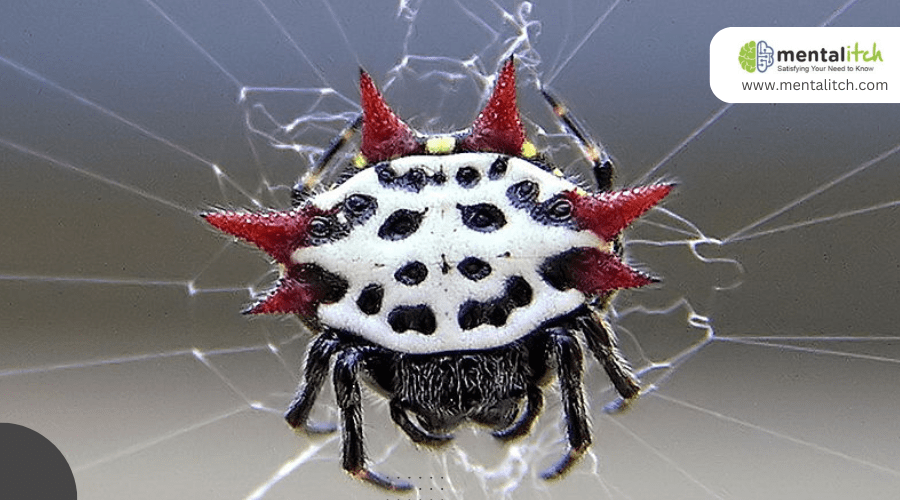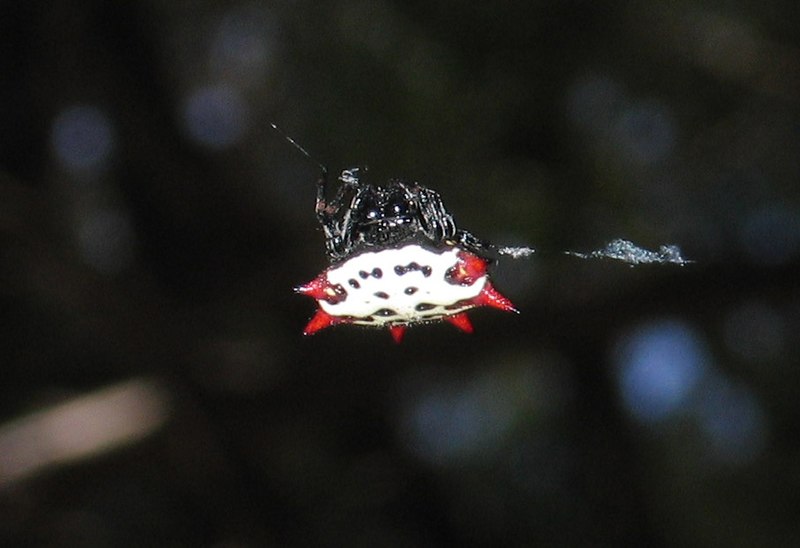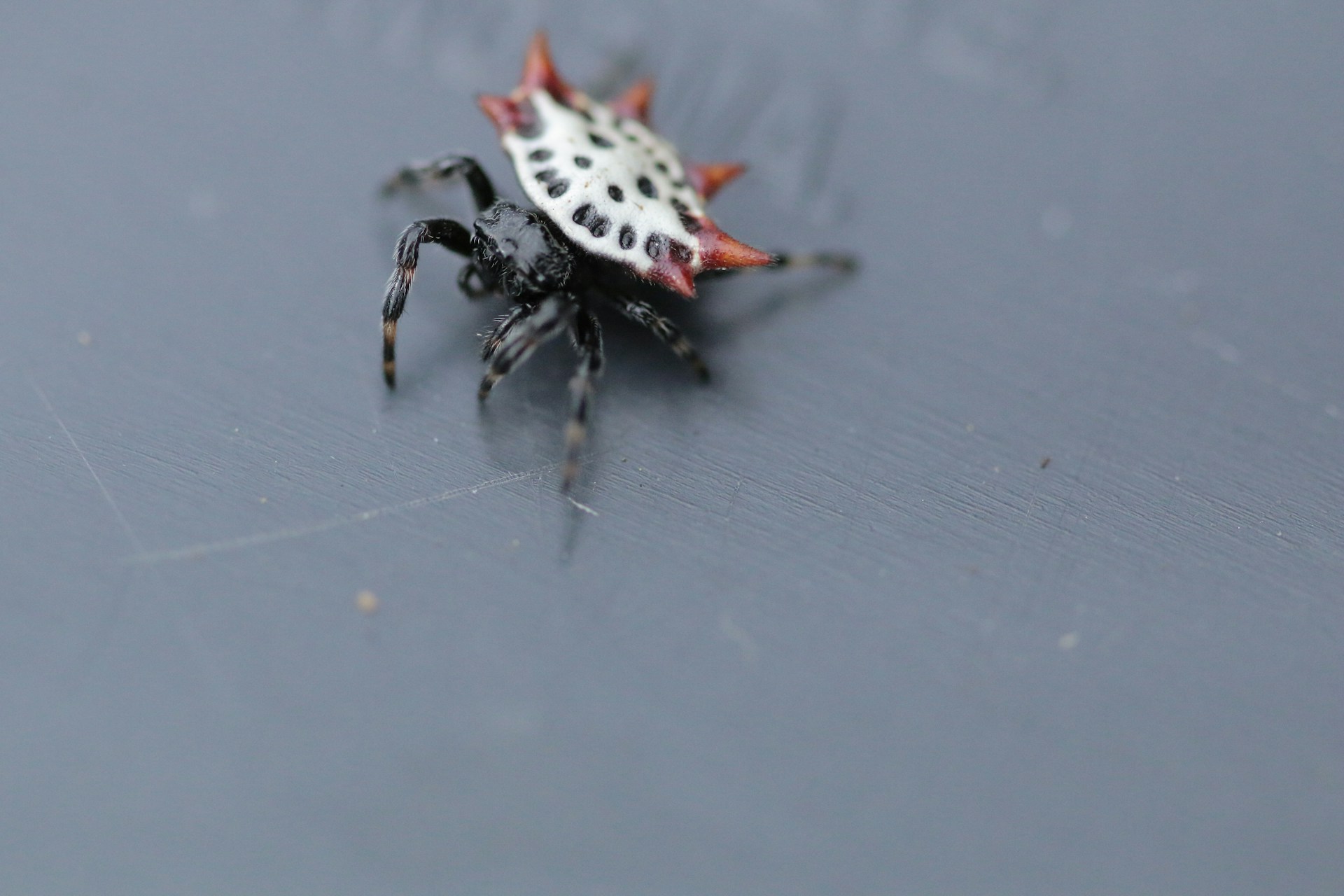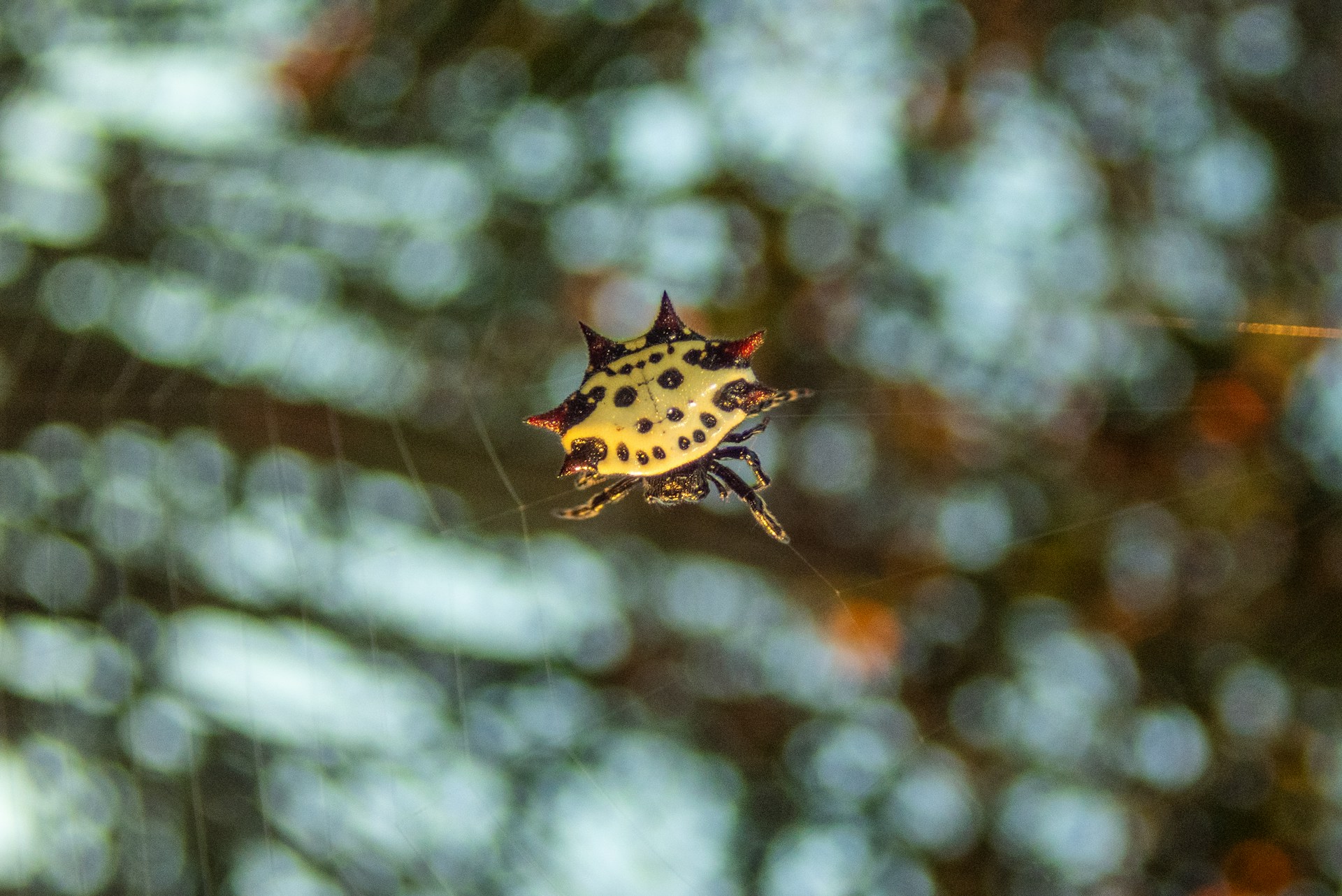Isn’t it fascinating how you might walk past a spiky-backed orb weaver without recognizing its unique features? You’re about to discover what sets this spider apart from its arachnid cousins. With its vibrant colors and distinctive spiky protrusions, the spiky-backed orb weaver is not just another spider. These creatures are not only crucial to humans but also play a crucial role in controlling pests. But there’s more to their story than meets the eye.
To uncover the secrets behind their web-building techniques and how they adapt to their environment, let’s explore the intricate world of these fascinating spiders.
Distinctive Appearance
Among the myriad of spiders, the Spiny-Backed Orb Weaver stands out due to its vibrant and spiky appearance. This unique spider captivates with its hard, white abdomen, adorned with conspicuous black spots and eye-catching red spines. It’s not just another face in the crowd of Orb weavers; it’s a visual spectacle in the spider world. The six pointed spines that decorate its abdomen are more than just ornamental; they give the Spiny-Backed Orb Weaver a distinctive silhouette that’s easily recognizable even from a distance.
While the females boast this colorful and spiky appearance, the males of the species take on a subtler guise, with gray bodies punctuated by white spots. This stark contrast between the sexes adds another layer of intrigue to their already fascinating aesthetic. The Spiny-Backed Orb Weaver’s unique look isn’t just for show; it sets it apart from other spiders, making it a subject of fascination and observation. You’ll find that its striking appearance, highlighted by the vibrant red spines and patterned abdomen, makes it a standout character in the diverse world of spiders.
Spiny Protrusions
Often, the spiny protrusions on a Spiny-Backed Orb Weaver’s abdomen are what first catch your eye, serving as both a critical mechanism and a unique identifier among spiders. These abdominal spines, typically red, lend a unique appearance that sets them apart from their arachnid cousins. But it’s not just about looks; these spiny protrusions play a vital role in their survival.
Here’s what makes them stand out:
- Distinctive spines: Their abdomen is adorned with spines that can vary in size and shape, making each spider uniquely identifiable.
- Red spines: The spines are often red, adding to their striking visual appeal and serving as a warning to potential predators.
- Defense mechanism: These spines are not just for show; they serve as an effective defense against predators, making them think twice before attacking.
- Camouflage and deterrence: Apart from defense, the spines may aid in camouflage or act as a deterrent, confusing or intimidating predators.
- Unique identifier: The presence of these spiny protrusions is a key feature that helps differentiate spiny-backed orb weavers from other spider species, contributing to their identification and understanding of their place in the ecosystem.
Vibrant Colors
While the spiny protrusions catch your eye, it’s the spiny-backed orb weaver’s vibrant colors that truly set them apart. These spiders boast a striking color combination that includes a white abdomen adorned with black spots and red spines, making them easily recognizable in their natural habitats. This colorful appearance isn’t just for show; it plays an essential role in their survival.
| Color | Function | Impact |
|---|---|---|
| White | Camouflage | Blends with light backgrounds |
| Black | Warning | Signals danger to predators |
| Red Spines | Warning | Indicates potential threat |
The vibrant colors serve a dual purpose: they act as both a warning to potential predators and as camouflage, aiding in protection from threats. This unique coloration is a key characteristic that distinguishes the spiny-backed orb weaver from other spider species. The combination of white, black, and red not only creates a visually striking spider but also an effective strategy for survival in the wild. So, while you’re captivated by their bright colors, remember, it’s all part of their intricate design for living safely among predators.
Web Building Techniques
How do spiny-backed orb weavers construct their intricate webs? If you’ve ever stumbled across a flat, orb-shaped web, you’ve witnessed the handiwork of the spiny orbweaver spider. These creatures are not just web architects; they’re master hunters, utilizing their web-building technique to trap their next meal.
The unique features of their webs aren’t just for show. They serve a critical role in the spiny orbweaver’s hunting strategy, meticulously designed to capture flying and crawling insects. Their commitment to web maintenance guarantees their homes are always in top condition for trapping prey.
Here’s a quick rundown of their web-building process:
- Use of silk: Spiny-backed orb weavers produce silk to create their webs.
- Orb-shaped design: Their webs are flat and orb-shaped, optimized for insect trapping.
- Maintenance: They constantly maintain and repair their webs.
- Outdoor construction: Webs are typically built in outdoor areas.
- Specialized technique: Their web-building method is specialized for capturing insects.
Environmental Adaptations
After exploring how spiny-backed orb weavers construct their webs, let’s examine how they’ve adapted to their environments to thrive. A unique feature, the abdomen spines, not only gives these spiders their name but also plays a vital role in their survival.
| Feature | Purpose | Benefit |
|---|---|---|
| Abdomen Spines | Deter predators & provide camouflage | Increases survival rates |
| Bright Coloration | Attract prey & warn predators | Enhances hunting efficiency & safety |
| Orb-shaped Webs | Efficient at catching prey in open areas | Maximizes food intake |
The spinybacked orbweaver’s ability to build orb-shaped webs in gardens and shrubs is an environmental adaptation that guarantees they catch enough prey to sustain themselves. Their striking appearance, featuring a white abdomen with black spots and red spines, not only makes them stand out but also serves as a warning to potential predators. This combination of visual signals to both prey and predators is a tribute to their adaptability.
Their tolerance for a broad range of temperatures and humidity levels underscores their versatility in different environments. This adaptability is a tribute to the spiny-backed orb weaver’s resilience, allowing it to thrive in varied settings.
Unusual Behaviors
Beyond their unique physical adaptations, spiny-backed orb weavers also exhibit behaviors that set them apart in the spider world. These spiders, while non-aggressive towards humans, have developed an array of unique behaviors to navigate their environment effectively. Here’s what makes their lifestyle so fascinating:
- Defense Mechanism: They’re known for their distinctive habit of dropping from their webs when threatened, a clever tactic to evade predators.
- Nesting Behavior: Spiny-backed orb weavers showcase an unusual nesting behavior, creating ovate egg sacs that house hundreds of eggs, ensuring the survival of their species.
- Essential Pest Control: By feeding on small insects caught in their intricate webs, they play a significant role in controlling pest populations without the need for chemicals.
- Extended Web Tenure: Female spiny-backed orb weavers tend to stay in the same web for long periods, showcasing a level of web fidelity not commonly observed in other spider species.
- Wandering Males: In contrast, male spiny-backed orb weavers wander extensively in their quest for mates, a behavior driven by their reproductive strategy.
Their unique behaviors, from their non-aggressive defense mechanism to their role in natural pest control, highlight the spiny-backed orb weaver’s important ecological role and its adaptability to various environmental challenges.
Diet and Predation
Having explored the unique behaviors of spiny-backed orb weavers, let’s now focus on their diet and how they prey on other insects. These fascinating spiders feed on small insects caught in their orb-shaped webs, playing an important role in natural pest control by consuming harmful pests. The method they use to capture their prey is quite ingenious. They snap the radii of their webs to ensnare unsuspecting insects, which are then carried to the central disk for feeding.
Once their prey is secured, spiny-backed orb weavers employ a remarkable process to consume their meals. They deliquify the carcasses of their prey insects, allowing them to ingest the nutritious liquid. This method of feeding not only provides them with the necessary sustenance but also helps maintain the cleanliness of their webs, as the deliquified carcasses are discarded from the web after feeding.
However, it’s worth noting that while they are predators, spiny-backed orb weavers also face threats from specialized predators. One such predator is *Phalacrotophora epeirae*, which preys on their eggs, showcasing the complex web of predator-prey relationships in nature.
Life Cycle
The life cycle of the spiny-backed orb weaver is a fascinating journey from egg to maturity. Beginning with the formation of ovate egg sacs, each containing between 100 to 260 eggs, these creatures set off on a life filled with growth, danger, and reproduction. However, it’s not all smooth sailing; specialized predators like Phalacrotophora epeirae pose threats to these eggs, showcasing the challenges these spiders face from the start.
- Spiny-backed orb weavers produce ovate egg sacs, each holding 100 to 260 eggs.
- Specialized predators, such as Phalacrotophora epeirae, can attack the eggs, highlighting the dangers from the very beginning.
- Spiderlings disperse within a week after hatching, venturing out into the world.
- Before mating, males engage in courtship rituals to win over females.
- Spiderlings reach maturity in a few months and disperse by ballooning, spreading far and wide to create their webs and reproduce.
This cycle of life, from egg sacs to spiderlings, through courtship rituals, and onto maturity and dispersal, illustrates the intricate and perilous life these creatures lead.
Habitat Preferences
Understanding the life cycle of spiny-backed orb weavers sets the stage for exploring where these intriguing spiders choose to live and thrive. Their habitat preferences are quite specific, favoring sunny areas where they can bask and hunt efficiently. You’ll often find them in gardens, where their presence is a boon for gardeners. These spiders act as natural pest control agents, preying on harmful insects that might otherwise damage your plants. But it’s not just gardens that appeal to them; forests and shrublands also provide ideal homes for spiny-backed orb weavers.
In these natural habitats, they weave their orb-shaped webs amidst low vegetation. This strategic placement allows them to capture small insects with ease, their primary food source. The adult females, responsible for constructing these intricate webs, tend to stay in one location for weeks. On the other hand, males are more nomadic, wandering in search of females for mating purposes. This division of labor and habitat preference safeguards their survival and plays a critical role in the ecosystem, highlighting the importance of sunny areas, gardens, forests, and shrublands in supporting the life cycle of these fascinating spiders.
Conclusion
To sum up, you’ve discovered that the Spiny-Backed Orb Weaver isn’t just any spider. With its vibrant colors, distinctive spiny protrusions, and intricate web-building skills, it stands out in the spider world. It’s adapted well to various environments, showing unique behaviors that fascinate. Its diet helps control pests, making it a friend in your garden. Understanding its life cycle and habitat preferences further highlights its role in nature. So, next time you spot one, you’ll appreciate its beauty and importance.



